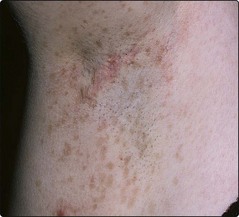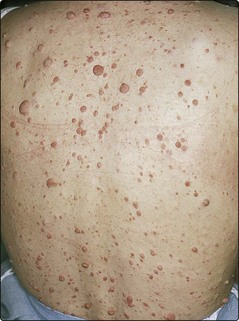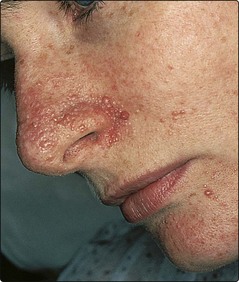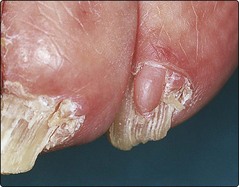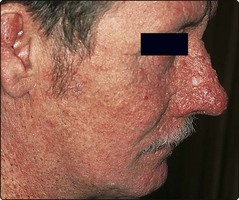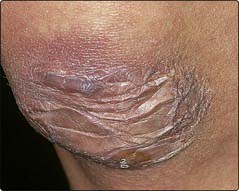Neurocutaneous disorders and other syndromes
Certain inherited skin disorders also have significant involvement of internal organs. The neurocutaneous disorders, the inherited diseases of connective tissue and the premature ageing syndromes are included.
Neurofibromatosis
Clinical presentation
The two main cutaneous features are:
1. Café-au-lait spots: round or oval coffee-coloured macules, due to increased melanin pigment. They often appear in the first year of life. One or two café-au-lait spots are seen in 10% of normal people but, in neurofibromatosis, six or more are usually present. Freckling of the axilla is also found (Fig. 1).
2. Dermal neurofibromas: small nodules that appear during childhood and increase in number at the time of puberty (Fig. 2). Their number varies from a few to several hundred.
Complications
Complications develop in many cases and include the following:
 Plexiform neurofibromas are larger than their dermal counterparts and measure up to several centimetres in size. They are associated with pigmentation and hypertrophy of the overlying skin or underlying bone, and present a cosmetic problem.
Plexiform neurofibromas are larger than their dermal counterparts and measure up to several centimetres in size. They are associated with pigmentation and hypertrophy of the overlying skin or underlying bone, and present a cosmetic problem.
 Benign tumours of the nervous system may develop. These include optic gliomas, acoustic neuromas and spinal neurofibromas that arise from nerve roots of the spinal cord.
Benign tumours of the nervous system may develop. These include optic gliomas, acoustic neuromas and spinal neurofibromas that arise from nerve roots of the spinal cord.
 Sarcomatous change in a neurofibroma, typically non-cutaneous, occurs in 1.5–15% of cases.
Sarcomatous change in a neurofibroma, typically non-cutaneous, occurs in 1.5–15% of cases.
 Kyphoscoliosis (in 2%) or bowing of the tibia and fibula may occur.
Kyphoscoliosis (in 2%) or bowing of the tibia and fibula may occur.
 Other problems include iris hamartomas (Lisch nodules), hypertension, epilepsy and learning difficulties.
Other problems include iris hamartomas (Lisch nodules), hypertension, epilepsy and learning difficulties.
Management
Once the diagnosis has been made, genetic counselling and the exclusion of any complicating factors are important. Troublesome nodules can be excised, and larger disfiguring neurofibromas removed by plastic surgery. Patients are often helped by contact with a patient support group (p. 132).
Tuberous sclerosis complex
Clinical manifestations
The features may not appear until puberty. Patients typically show the following:
 Adenoma sebaceum: red–brown angiofibromatous papules that are usually found around the nose (Fig. 3). They appear in childhood.
Adenoma sebaceum: red–brown angiofibromatous papules that are usually found around the nose (Fig. 3). They appear in childhood.
 Periungual fibromas: pink fibrous projections are seen under the nail folds (Fig. 4).
Periungual fibromas: pink fibrous projections are seen under the nail folds (Fig. 4).
 Shagreen patches: connective tissue naevi, soft, yellowish with a cobblestone surface, are found on the lumbosacral region.
Shagreen patches: connective tissue naevi, soft, yellowish with a cobblestone surface, are found on the lumbosacral region.
 Ash-leaf macules: small (1–3 cm long) white oval macules, sometimes present at birth, and best seen with a Wood’s light.
Ash-leaf macules: small (1–3 cm long) white oval macules, sometimes present at birth, and best seen with a Wood’s light.
 Neurological involvement: learning difficulties and epilepsy affect 60–70% of cases. Intracranial calcification is seen.
Neurological involvement: learning difficulties and epilepsy affect 60–70% of cases. Intracranial calcification is seen.
 Other features: retinal phacomas, cardiac rhabdomyomas and renal tumours are found.
Other features: retinal phacomas, cardiac rhabdomyomas and renal tumours are found.
Management
An affected individual should have a full clinical examination, often with radiographs and magnetic resonance imaging (MRI) of the head. Children are screened for ash-leaf macules using a Wood’s light. The angiofibromas may be improved by hyfrecation or laser, but tend to recur. Genetic counselling is given once the diagnosis is made. The support group is helpful (p. 132).
Incontinentia pigmenti
Incontinentia pigmenti is a rare X-linked dominant condition that is usually lethal in utero in males. In females, it presents within a few days of birth as a widespread blistering eruption (p. 13). Warty papules follow, but are replaced by hyperpigmentation, which appears in a whorled pattern. Skeletal, ocular, neurological and dental abnormalities are associated.
Xeroderma pigmentosum
Xeroderma pigmentosum is a group of rare autosomal recessive conditions characterized by defective repair of ultraviolet (UV)-damaged DNA. Photosensitivity begins in infancy, and freckles and keratoses appear on exposed skin in childhood. Squamous cell and basal cell carcinomas, keratoacanthomas and malignant melanomas subsequently develop in the UV-damaged skin (Fig. 5). Strict sunlight avoidance is necessary but, in its severe form, the disease can be fatal in the first or second decade. The gene loci are known (p. 12). Prenatal diagnosis is possible (p. 91) and is used when parents have already had one affected child.
Ehlers–Danlos syndrome
At least 10 inherited disorders of defective collagen structure and biochemistry are included in this group of conditions (gene loci: p. 12). The diseases may be dominant, recessive or X-linked, and present in varying degrees of severity. The features include:
In the more severe types, aneurysms and rupture of large arteries may be found.
The premature ageing syndromes
Aged skin is dry, wrinkled, atrophic, shows loss of elasticity and uneven pigmentation and is susceptible to the development of benign and malignant tumours. Photoageing from chronic sun exposure (p. 106) can produce similar changes, although certain of the features are more prominent. Some conditions, such as pseudoxanthoma elasticum or xeroderma pigmentosum, have the signs of aged skin without necessarily showing more generalized features of ageing.
Neurocutaneous disorders and other syndromes
 NF1 neurofibromatosis is a relatively common autosomal dominant condition characterized by café-au-lait spots, dermal neurofibromas and often skeletal or neurological anomalies. The abnormal gene is on chromosome 17.
NF1 neurofibromatosis is a relatively common autosomal dominant condition characterized by café-au-lait spots, dermal neurofibromas and often skeletal or neurological anomalies. The abnormal gene is on chromosome 17.
 Tuberous sclerosis complex is a not infrequent autosomal dominant disorder with prominent skin signs (e.g. facial angiofibromas and periungual fibromas), neurological problems (mental retardation and epilepsy) and ocular, cardiac and renal tumours.
Tuberous sclerosis complex is a not infrequent autosomal dominant disorder with prominent skin signs (e.g. facial angiofibromas and periungual fibromas), neurological problems (mental retardation and epilepsy) and ocular, cardiac and renal tumours.
 Incontinentia pigmenti is a rare X-linked dominant disease, present at birth, which evolves through vesicular and warty stages to leave whorled patterns of pigmentation. Skeletal, ocular and neurological defects are associated.
Incontinentia pigmenti is a rare X-linked dominant disease, present at birth, which evolves through vesicular and warty stages to leave whorled patterns of pigmentation. Skeletal, ocular and neurological defects are associated.
 Xeroderma pigmentosum represents a group of rare recessive conditions showing defects of DNA repair, characterized by skin tumours and premature death.
Xeroderma pigmentosum represents a group of rare recessive conditions showing defects of DNA repair, characterized by skin tumours and premature death.
 Ehlers–Danlos syndrome is a group of at least 10 inherited collagen disorders in which skin elasticity and scarring and joint hypermobility are found.
Ehlers–Danlos syndrome is a group of at least 10 inherited collagen disorders in which skin elasticity and scarring and joint hypermobility are found.
 Pseudoxanthoma elasticum represents at least five disorders that result in calcification of elastin. The skin is wrinkled with yellowish papules. Retinal angioid streaks are seen.
Pseudoxanthoma elasticum represents at least five disorders that result in calcification of elastin. The skin is wrinkled with yellowish papules. Retinal angioid streaks are seen.

